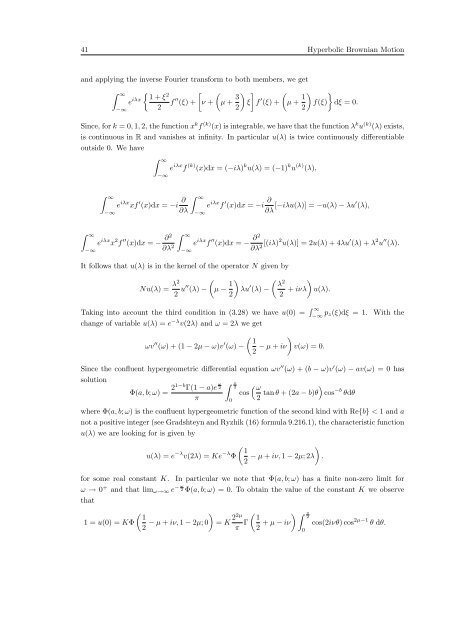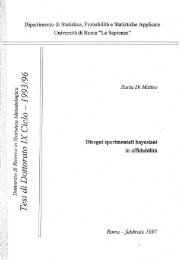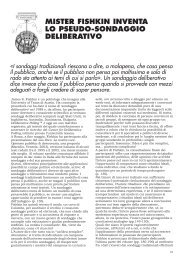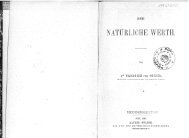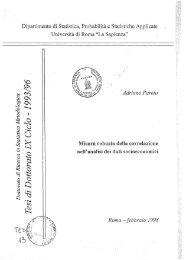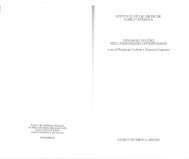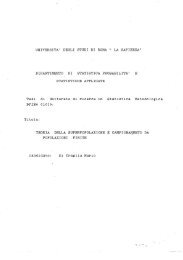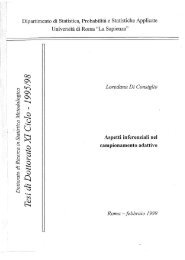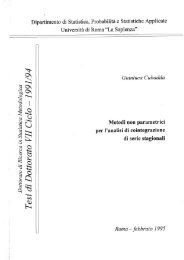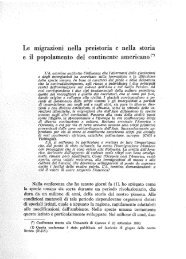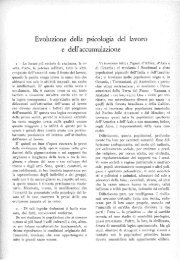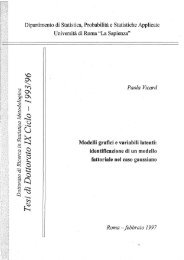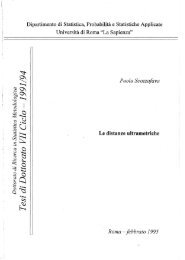Random Processes in Hyperbolic Spaces Hyperbolic Brownian ...
Random Processes in Hyperbolic Spaces Hyperbolic Brownian ...
Random Processes in Hyperbolic Spaces Hyperbolic Brownian ...
Create successful ePaper yourself
Turn your PDF publications into a flip-book with our unique Google optimized e-Paper software.
41 <strong>Hyperbolic</strong> <strong>Brownian</strong> Motion<br />
and apply<strong>in</strong>g the <strong>in</strong>verse Fourier transform to both members, we get<br />
∞<br />
−∞<br />
e iλx<br />
2 1 + ξ<br />
f<br />
2<br />
′′ <br />
(ξ) + ν + µ + 3<br />
<br />
ξ f<br />
2<br />
′ <br />
(ξ) + µ + 1<br />
<br />
f(ξ) dξ = 0.<br />
2<br />
S<strong>in</strong>ce, for k = 0, 1, 2, the function xkf (k) (x) is <strong>in</strong>tegrable, we have that the function λku (k) (λ) exists,<br />
is cont<strong>in</strong>uous <strong>in</strong> R and vanishes at <strong>in</strong>f<strong>in</strong>ity. In particular u(λ) is twice cont<strong>in</strong>uously differentiable<br />
outside 0. We have<br />
∞<br />
e<br />
−∞<br />
iλx f (k) (x)dx = (−iλ) k u(λ) = (−1) k u (k) (λ),<br />
∞<br />
−∞<br />
∞<br />
−∞<br />
e iλx xf ′ (x)dx = −i ∂<br />
∞<br />
e<br />
∂λ −∞<br />
iλx f ′ (x)dx = −i ∂<br />
∂λ [−iλu(λ)] = −u(λ) − λu′ (λ),<br />
e iλx x 2 f ′′ (x)dx = − ∂2<br />
∂λ2 ∞<br />
e<br />
−∞<br />
iλx f ′′ (x)dx = − ∂2<br />
∂λ2 [(iλ)2u(λ)] = 2u(λ) + 4λu ′ (λ) + λ 2 u ′′ (λ).<br />
It follows that u(λ) is <strong>in</strong> the kernel of the operator N given by<br />
Nu(λ) = λ2<br />
2 u′′ <br />
(λ) − µ − 1<br />
<br />
λu<br />
2<br />
′ <br />
2 λ<br />
(λ) − + iνλ u(λ).<br />
2<br />
Tak<strong>in</strong>g <strong>in</strong>to account the third condition <strong>in</strong> (3.28) we have u(0) = ∞<br />
−∞ pz(ξ)dξ = 1. With the<br />
change of variable u(λ) = e −λ v(2λ) and ω = 2λ we get<br />
ωv ′′ (ω) + (1 − 2µ − ω)v ′ <br />
1<br />
(ω) − − µ + iν v(ω) = 0.<br />
2<br />
S<strong>in</strong>ce the confluent hypergeometric differential equation ωv ′′ (ω) + (b − ω)v ′ (ω) − av(ω) = 0 has<br />
solution<br />
Φ(a, b; ω) = 21−b Γ(1 − a)e ω<br />
2<br />
π<br />
π<br />
2<br />
0<br />
<br />
ω<br />
<br />
cos tan θ + (2a − b)θ cos<br />
2 −b θdθ<br />
where Φ(a, b; ω) is the confluent hypergeometric function of the second k<strong>in</strong>d with Re{b} < 1 and a<br />
not a positive <strong>in</strong>teger (see Gradshteyn and Ryzhik (16) formula 9.216.1), the characteristic function<br />
u(λ) we are look<strong>in</strong>g for is given by<br />
u(λ) = e −λ v(2λ) = Ke −λ <br />
1<br />
Φ − µ + iν, 1 − 2µ; 2λ .<br />
2<br />
for some real constant K. In particular we note that Φ(a, b; ω) has a f<strong>in</strong>ite non-zero limit for<br />
ω → 0 + ω − and that limω→∞ e 2 Φ(a, b; ω) = 0. To obta<strong>in</strong> the value of the constant K we observe<br />
that<br />
<br />
1<br />
1 = u(0) = KΦ − µ + iν, 1 − 2µ; 0 = K<br />
2 22µ<br />
π Γ<br />
π<br />
1<br />
2<br />
+ µ − iν cos(2iνθ) cos<br />
2 0<br />
2µ−1 θ dθ.


